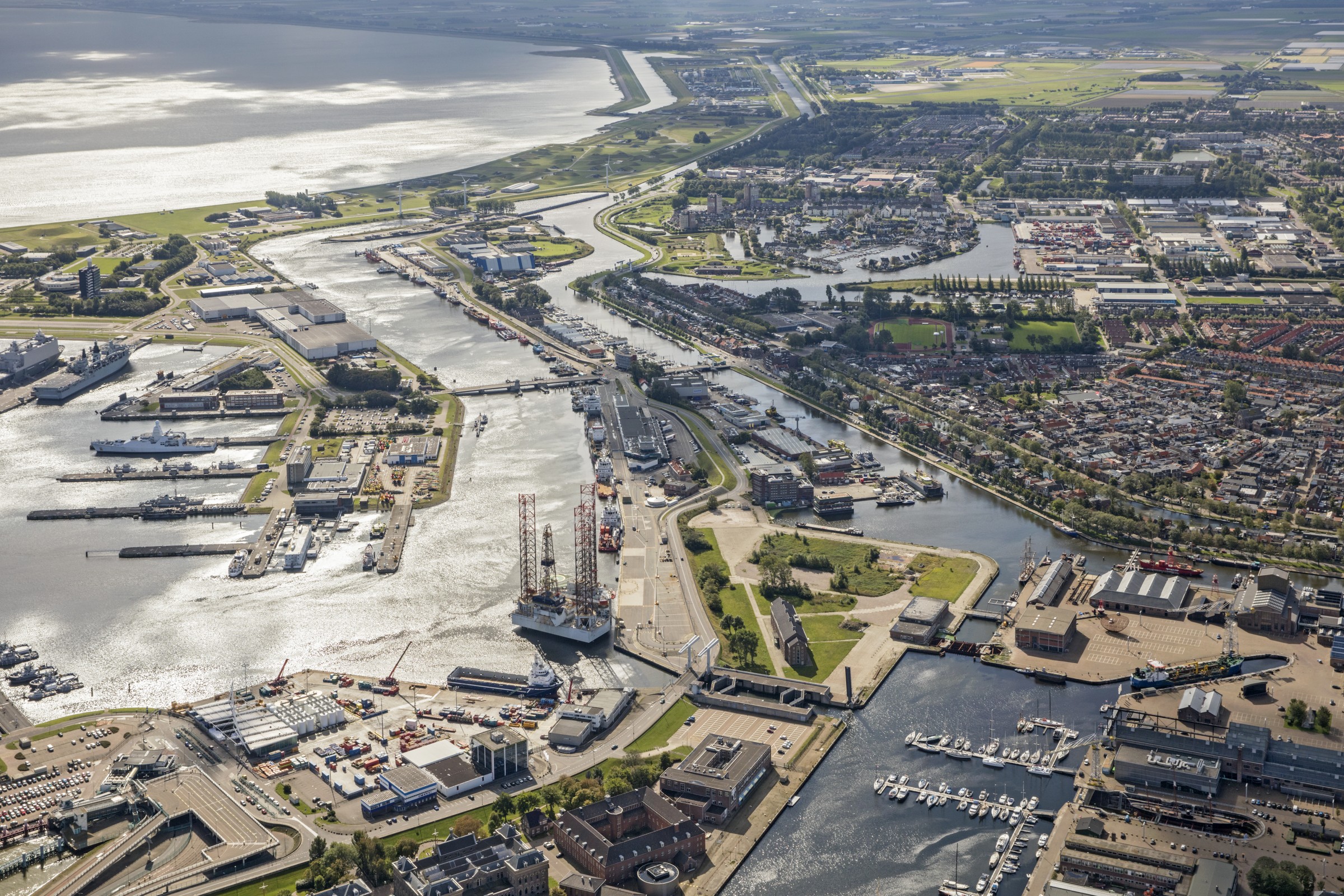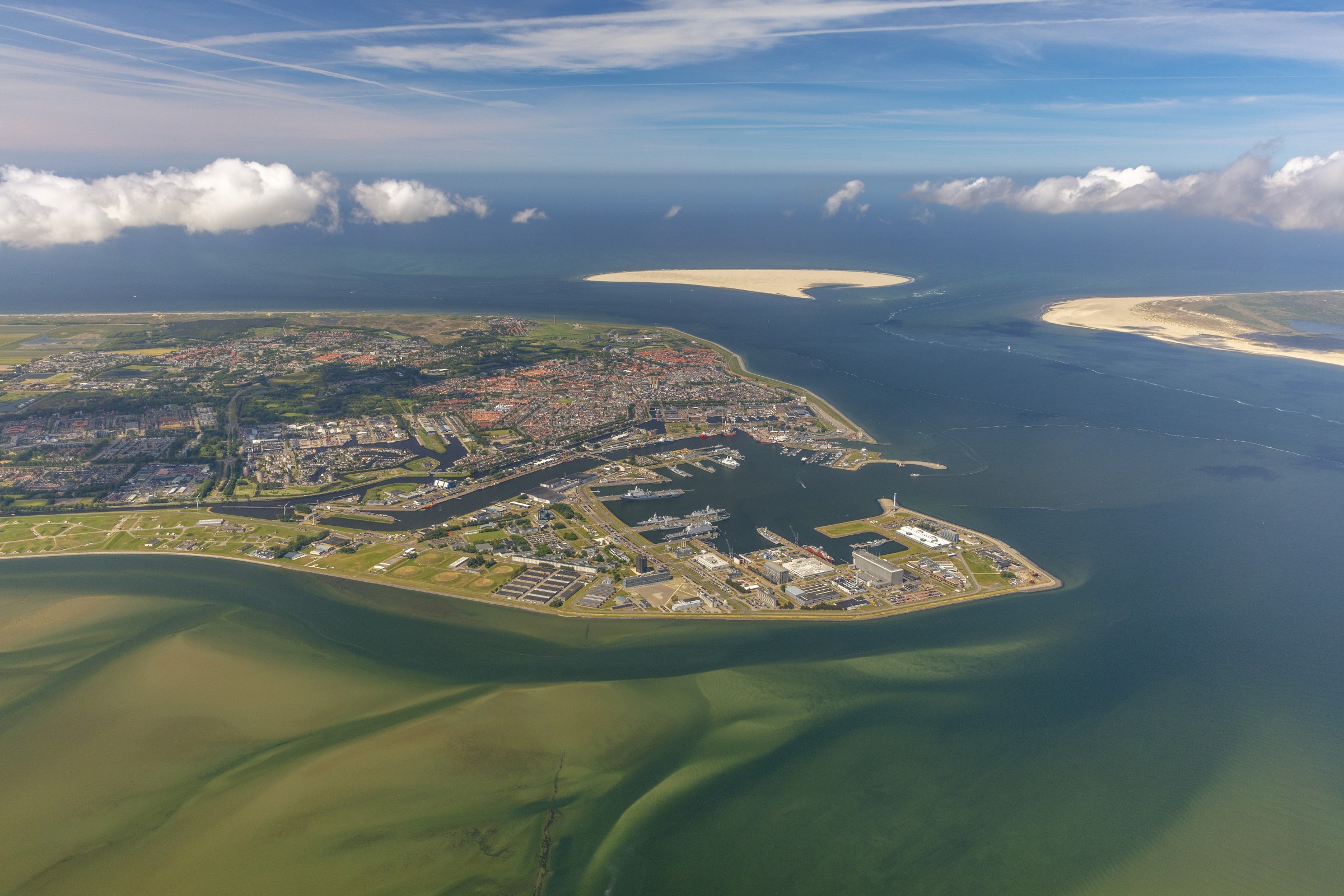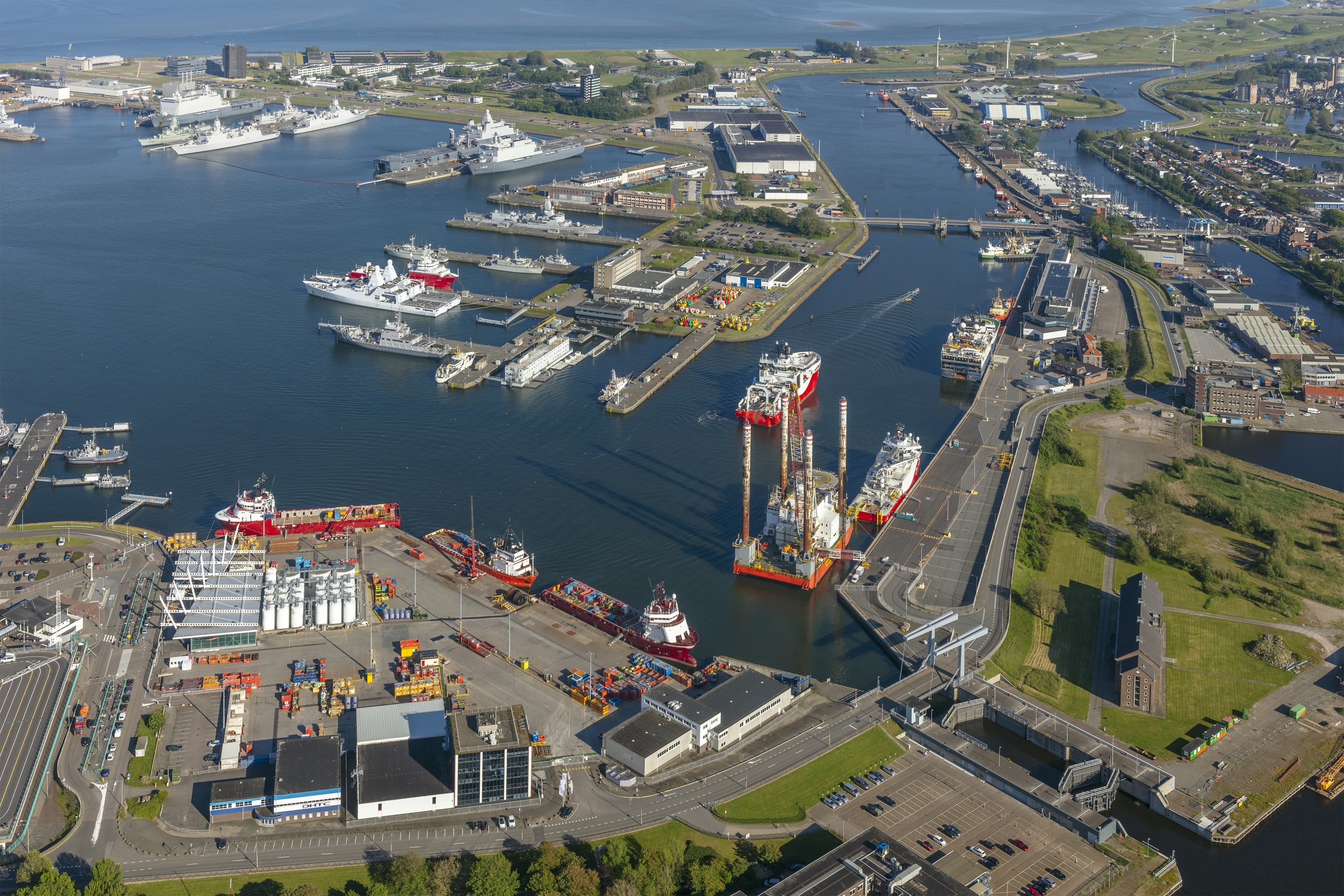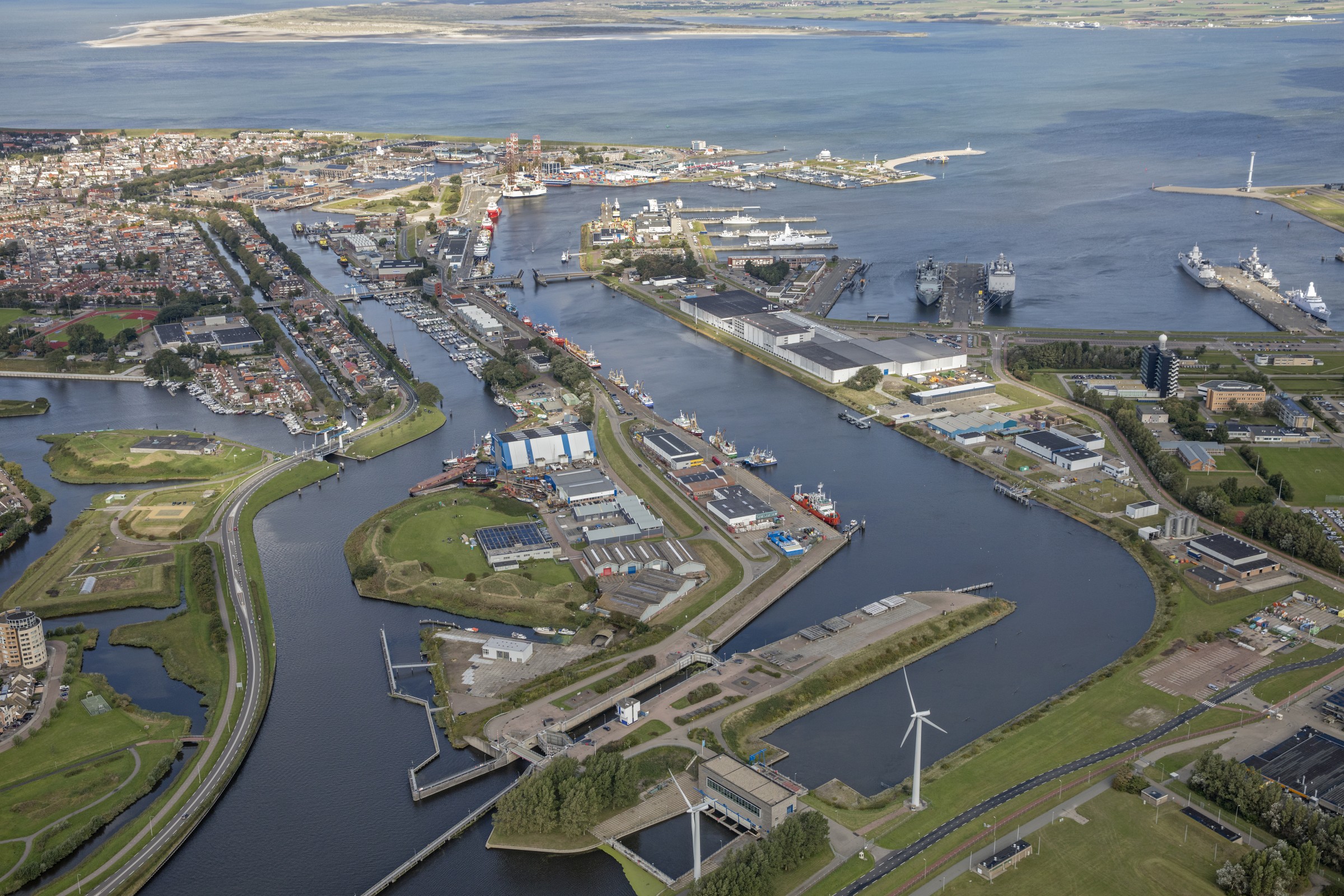30 June 2021
This month ESPO is interviewing Ms Jacoba Bolderheij, CEO of the Port of Den Helder. In what follows, you will learn more about Ms Bolderheij’s vision for the Port of Den Helder for the next decade, the Port’s role and future as offshore industry and hydrogen hub, how she got into the port sector, and many other interesting topics!
 © Peter van Aalst
© Peter van Aalst
Can you briefly tell us about the Port of Den Helder? What are its main characteristics and challenges?
First of all Port of Den Helder is a very specific port. Where sea ports’ usual activities are concentrated on transit and/or transhipment of cargo and the port functions as a gateway to the country and its hinterland or functions as a hub. The focus of the port of Den Helder is on services at sea. For over 40 years the Port of Den Helder has been the pit stop port for logistics services for offshore maintenance and supply activities at (the southern part of) the North Sea. More than a hundred installations are busy with gas production at the North Sea and all these assets need supplies and maintenance. Port of Den Helder is the most prominent offshore operations and maintenance hub in the Netherlands and around the North Sea.
What is your vision for the Port of Den Helder for the next decade? What are the main investment projects in the port for the coming years?
A bright future lies ahead of us. Though our energy consumption will be decarbonised, we anticipate that for some decades gas will keep on playing an important role in the energy mix. Of course, we also know that it is ending. We need to decarbonise, no doubt; and our government is working hard on that with an ambitious scheme to develop wind parks at sea and to develop a H2 policy. The ambition is to have realised by 2030 11GW of wind offshore parks. Some of these parks are very close to the Port of Den Helder. But much more is needed; some 40-70 GW is needed to adhere to the climate goals set for 2050. The installed base of parks needs to be increased big time and the good news for our port is that some 30GW will be built as from 2030. Around 8 areas have been identified as potential locations, all within the vicinity of Port of Den Helder.
Therefore, we need to invest in our infrastructure. The infrastructural wishes we have are relatively modest. We don’t envisage to become an installation port; we stick to our strength and the expertise of our service providers; the Port of Den Helder is a perfect location to operate as an operations and maintenance hub for wind offshore projects, like we are known for the gas sector. Hence, we estimate we need an approximate 6 hectares, with some extra quay length. Relatively modest amounts, but enough for the future ahead of us which includes offshore wind, H2 developments and decommissioning. With TNO research we calculated that for these activities our infrastructural development demands suffice.
 © Flying Focus
© Flying Focus
The Port of Den Helder is the largest offshore industry hub in the North Sea. Which kind of offshore industry activities exist in the port? Why is the offshore industry so prominently present in the Port of Den Helder? What are the factors that contribute to the success of the offshore industry in the port?
It’s all about location. The Port of Den Helder is at the centre of the North Sea. All gas assets on the Dutch shelve are relatively close by; and this also is true for the wind offshore parks, especially those which are planned on the short, medium and long term. Those are all within easy reach and attractive distances and travel time. The Port of Den Helder is directly accessible from the sea, no locks, no bridges, has very favourable tidal conditions and is relatively sheltered. Easy in and easy out. Furthermore, it has a very good heliport; a heliport which has the highest standards when it comes to safety and security and has all the soft infrastructure available to transfer personnel, including immigration facilities. The port and airport are only minutes away from each other; as such, superefficient logistic solutions have been developed. Our service providers in Den Helder have made an art out of that and are therefore experts in developing effective and efficient servicing and logistical concepts. As a matter of fact, the Port of Den Helder and partners are now working on a new study in which we will deep dive into future concepts fusing wind offshore concepts with gas offshore, including the future of autonomous sailing. The idea is to develop new ideas on how to optimise the “logistics train” of operation and maintenance of offshore assets.
Ports, certainly in Europe, have to obtain their licence to operate as well as their licence to grow. In a world of transitions, creating added value for the community could become more challenging. How is the Port of Den Helder remaining relevant to the surrounding community and the broader region?
An excellent question. In our region some 4000 jobs are related to port activities; and some 250 companies add approximately €650 million to our regional economy. For the city of Den Helder and our region, these figures are very, very relevant. Our licence to operate is very much founded in these statistics. Every day, our team puts all its efforts into growing these statistics by promoting our port, by marketing our proposition, by maintaining our infrastructure, by developing new business. Day in, day out, non-stop. In addition, we pay attention to our own footprint; a port so close to the city centre must pay attention to noise and emissions reduction. Many projects have been executed over the past years to reduce our footprint as much as possible. The ambition is to have the Port Authority's business operations climate-neutral by 2025. But this ambition goes further and aims for a completely climate-neutral port chain by 2050. As a Waddenzee port we have ambitions and responsibilities as well. We do work in the framework of the Dark Sky convention and do our utmost best to contribute to green shipping programmes through our H2 ambitions, onshore power supply and H2 ‘bunkering stations’.
Needless to say, we are very proud we have been EcoPorts certified for several years now.
 © Flying Focus
© Flying Focus
The Port of Den Helder also wants to become a green hydrogen hub. Can you briefly tell us more about your plans to develop the hydrogen industry in the port? Do you believe hydrogen will become a global energy commodity in the future?
I strongly believe that H2 will become an energy commodity. We certainly need to import and I see that the current liquid hubs in the Netherlands like Amsterdam and Rotterdam can play a major role here. Talking about the role of Den Helder, we focus on the development of infrastructure required for the transition of our port from North Sea gas hub to hydrogen hub. The strategy aims to realise a landing point in Den Helder for a substantial part of the green hydrogen production at sea. Our main asset is the existing pipeline infrastructure which is now used for the offshore gas production at sea; we envisage those pipelines to be used for green hydrogen molecules in the future.
Furthermore, we are working on a blue hydrogen project. Together with other major players in the energy sector including grid operators, grid owners and operators, we strongly believe that blue hydrogen is the-must-take-step towards green hydrogen. Since the majority of the gas production at the North Sea comes to shore via Den Helder, we are studying the potential of a facility which converts gas into hydrogen while allowing CO2 to be pumped back via the same existing infrastructure into depleted gas wells. This project is a strategic building block in upscaling large-scale use of hydrogen in the process industry and energy generation. At the end of this year, we trust to have proofed the (financial and technical) feasibility of this project.
The other project is a green hydrogen filling station in our area. The hydrogen for this filling station is produced locally by electrolysis of green electricity by one of our consortium partners and partly obtained from the network. With this initiative, the Port of Den Helder aims to facilitate zero-emission mobility on road and water by 2022. The project includes a sailing demonstration vessel and a ‘water cab’ propelled entirely by ‘green’ hydrogen. This vessel is being tested by a pool of port users.
The Port of Den Helder is the home port for the Royal Netherlands Navy. Is there an added value to being the home port for the Navy? Does it also come with business opportunities?
Yes, obviously. In particular, ship repair creates business opportunities there. And of course in the development of new technologies. The Navy is a very innovative organisation and in that environment, sustainability of sailing assets is also key. So cross-over potential has our continuous attention. Last but not least, hundreds of commercial suppliers service the Navy; it would be great if some of those companies find a permanent residence in Den Helder at our business parks.
 © Flying Focus
© Flying Focus
The COVID-19 crisis is having a profound impact on the European economy and society. What has been the impact of this crisis on the Port of Den Helder?
Gas prices plummeted. This had a substantial impact on gas-related activities at the North Sea. So you can imagine that the amount of ships used by the sector decreased, and in line with that so did our port calls. We are happy that we see some recovery.
In order to get goods to the desired destinations, good hinterland connections to the port are of paramount importance. Can you briefly describe how the Port of Den Helder is connected to its hinterland?
We continuously ask for attention for connectivity, despite the fact that we are only 60 minutes from Schiphol Airport by car; on most of the time traffic jam-free roads. Nevertheless it is paramount that improvements are made, in particular in the city itself, where in the holiday season, commercial traffic and holidaymakers are not always each other’s best friends. The smoother, the better we would say; we are pleased that connectivity is always top of the list of our regional policy makers.
The Port of Den Helder is part of ESPO’s EcoPorts network and has already obtained the PERS (Port Environmental Review System) certification multiple times, which is the only port sector specific environmental management standard. What are the main focal points of your port’s environmental policy? How do you think the port sector could contribute to decarbonising the logistics chain?
We look at three levels of sustainability and environmental policy: 1) Energy, 2) Emissions, 3) Circularity. (Since I have elaborated already on some aspects,) I would like to give some examples on what we do on each level. 1) Energy: In our own operations, we obviously use green electricity, focus on electric driving, improve the energy label of our office building and sustainable procurement. On the second level (Emissions), we have been developing shore power, and working on our hydrogen filling station and our blue H2 project. On level 3 (Circularity), in the future we envisage a role in the circularity of offshore wind components and decommissioning of gas infrastructure.
 © Flying Focus
© Flying Focus
Some weeks ago ESPO, together with Deloitte, published a study on the changing role of ports. One of the conclusions of the study is a possible tension between the long-term perspective and long lead times for port investments and the short-term changing realities impacting ports. Do you agree with this conclusion?
Ports are crucial in the energy transition, in world-wide trade, and for the communities they operate in. All ports need to anticipate market developments and to invest to stay relevant and, as such, to be able to play a local, regional and national role in the often long-term ambitions on again various (local, regional and even national) levels. At the same time, whereas the importance of ports is clear and investments are needed continuously, revenue streams are not always stable. Furthermore, to anticipate on new market developments or realities is complicated. Investing in infrastructure in ports has long lead times, while the markets outlook may be uncertain. This means that taking certain investment risks should be taken into account and might be part of the game, if a port embraces the ambition to take up those crucial roles.
How did you get into maritime transport? How did your career path lead to this position?
Via a diplomatic route, I got into touch with Port of Rotterdam and 10 years ago I started as commercial manager in their joint-venture in Oman, with Sohar Industrial Port Company. I got the taste of it straight away from day one. The place ports have in society is intriguing and I love the business taking place in ports. It is all part of a bigger framework, a bigger system of indispensable services and activities. Some years ago I moved back to the Netherlands and for over 5 years now I put all of my energy in putting Port of Den Helder on the map. It’s a great place for doing business. A hidden gem at the North Sea, which all of you out there need to discover at the soonest!
Related documents
No attachments.
